Consequence Alternative
Personal Record
Tron
At four years of age, Tron was an expert at tattling on other children. When he saw something bad happen outside; he ran inside to tell an adult, usually me, what had happened. With energetic concern he would say things like, “Mark just threw sand over the fence!”
Again. Again. Again. It seemed Tron’s major outdoor activity was to look for transgressions, so he could run to me with the report. I would answer by saying a variant of, “I won’t do anything about what I haven’t seen. I was not there. The community of adults and children outside can deal with it. I am getting circle time ready for everyone, so telling me about something that is happening outside doesn’t have any effect.”
I tried to be honest (it got clearer with practice), but honed straight messages never seemed to deter Tron. I continued to receive regular reports from him from the battlefront. Eventually I decided I had been talking to him too much, assuming that was why this went on so long. Something in our interaction must have been enjoyable. I decided to try ignoring and go about my work. It didn’t work. He kept on keeping on. I had to find another way, so I drew this picture and fastened it to a clipboard ready for the next day. It was my first Personal Record.
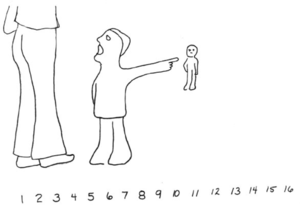
When Tron entered the classroom in the morning I called him aside to explain. “I drew this picture of someone who is pointing to another child. He is telling an adult that someone else has made a mistake. That is called tattling. I made this recording sheet for counting tattles. It comes with this pen. When you tattle on another child, I am going to hand you the pen. Your job is to circle the next number. That’s all there is to it. By the way, it’s so nice to see you!”
The next time he told a story about some other child’s mistake, I handed him the clipboard and said, “Here is your pen.” He circled the numeral 1, and I returned the clipboard to the shelf. That was it. The last numeral he ever circled was 7.
Personal Record is my first choice among the new consequence alternatives, when a problem gets to this Protocol level. It’s simple to do. The adult says nothing other than “Time to mark your chart. Here’s your pen.” No need to comment after the child makes a mark—especially not thanking the child. The child is not doing this for you, so why thank the child? The child is doing this for them. No thanks are needed from anyone.
No incentives are needed either, such as a treat for no-mistake days. If one wanted to offer some additional support, I suggest showing the clipboard and simply saying, “No marks today. How about that.” And put it back.
Essentially, a Personal Record is Neptune’s trident: a consistent response from adults, an interruption to the flow, and facts for the child to process over time. Somehow, that is enough. Physical reality, in this case one’s own counts, may be the key to transferring responsibility to the child for dealing with the mistake. Without extra hoopla, those conditions operate cleanly.
It is a personal record—not hidden—but not in public view either. I’ve kept charts on a clipboard on an adult counter to avoid the appearance of shaming or ridicule. I made an exception, however, for Henry.
Henry
Ever had a child that seemed eager to be up on the table on his stomach or knees rather than use a comfortable chair? Usually I don’t care much, but if it keeps going for months or it interferes with the others, I seek a way to do something about it in a respectful way. I tried ignoring. Didn’t work. None of the other consequence types discussed above seem applicable. Shall I deny him the activity for a minute or two? Should I use a Time Out? Should I yell at him?
I drew my second Personal Record. When Henry was at a table activity, I taped a half sheet of paper beside his work or snack with this image on it. “When you are up on the table, Henry, I am going to say ‘Time to mark your chart.'” After three days he never was up on the table again.
I am not sure why the Personal Record works so powerfully. The data and inner decisions connect somehow. I think we all would agree that internal self-reflection and self-correction are useful for everyone who wishes to alter habits. It helped me get out the door and run around Green Lake.
Diane
I do believe emotional expression is essential for healthy self-image and healthy relationships, so crying is not a behavior problem. I also believe that children must have the opportunities to experience problems in their relationships — losing friends, restoring friends, and exploring interpersonal power — some of which can be upsetting. However, Diane was doing something else with her tears. It seemed that she was almost obsessive in securing the status of her friendships with the other girls, especially with two girls who were friends with everyone. We watched this play out over months assuming things would work themselves out, for that’s what children are supposed to be doing in school.
Our concern grew with how Diane was managing herself. When confronted with a problem she turned on the waterworks with amazing rapidity — big time tears. The others would go to her, touch her shoulder, and comfort her. By February it seemed Diane was using power crying several times a day to get her way. We decided to try using a Personal Record on her “tears”, but restrict it to group times only, when we were leading the community. Her tear episodes were affecting the community. She could keep using tear episodes in free times, because we valued her freedom to get this worked out with the other children.
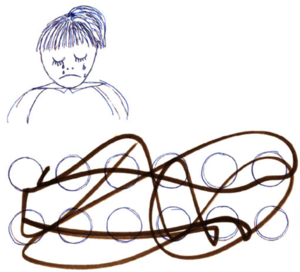
I sketched this girl in tears and wanted to experiment with marking circles rather than circling numbers. I explained it to her using the same procedure as above. I told her of our adult discussion, our conversations with her mother, and the reasons for choosing this option.
This is what she did when she was invited to mark her chart at the next circle time. I include it here to show our disregard for neatness. If they wish to, children can deface, tear, or destroy their recording sheet. It is not time for power struggles. The paper is a consumable; we have fresh charts ready to offer at any time.
It was interesting to watch her sniffle on the way to the clipboard and return totally composed. By the next week this tear business ended. It never happened again, even in the free times. I think her relationships improved because she was expressing herself with words instead of this old habit.
Ricky
Extroverted Ricky was a five-year-old powerhouse with unsuccessful social relationships. Although he was verbally expressive, active, and creative, he was also hurting other children’s feelings with what he so blatantly expressed. “I don’t want you to come near me.” “I don’t like your idea.” “I wish you would leave.” “I want you to go away.” “I don’t want you to put that on here.” When we collected these examples, we were surprised to find that these were not disparaging or pejorative. These were all self-expressions beginning with “I.” If they were put-downs, we would have immediately intervened with something, because that would be non-negotiable in my classroom. Since these were I-statements, we waited to let him work it out. We watched as others continued to avoid him and not include him in their play. Since 5 is such an essential time of life for positive social relationships to be established, we decided to intervene.
We first created a list of these hostile-toned self-expressions, so we had the behavior listed exactly. For lack of a better word for this kind of list, we invited him to relegate all these kinds of expressions to the garbage. Discard them. I drew a rough image of him along with the standard Seattle garbage can.
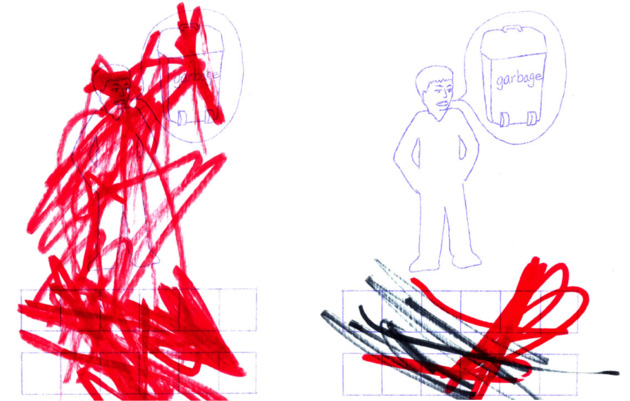
As you can see Ricky was not very happy about marking his chart. He always defaced it in some way, so in order to keep a count we changed colors of pens: on the left is one instance; on the right is two. After one week his “garbage” dropped to one per week; after three weeks they were gone. I have a memorable video tape of 8 children building this massive wall of unit blocks. I have used this 12 minute tape in classes to have people define social competence, because all of the children were so positive in their relationships with the each other, not just their best friends. About 6 minutes into the clip Ricky enters the screen announcing, “I want to be here.” He was lovely.
Lisa
In contrast to Ricky, four-year-old Lisa was, unfortunately, the master of put-downs, she averaged about 30 nasty, judgmental comments about others per day. “You’re ugly.” “You are stupid.” “That’s dumb.” “You’re dumb.” When the natural rejoinders of the other children didn’t seem to decrease the frequency of her negativity, we decided to try the Personal Record. I drew it with lots of marking blocks because she would average more than 20 a day.
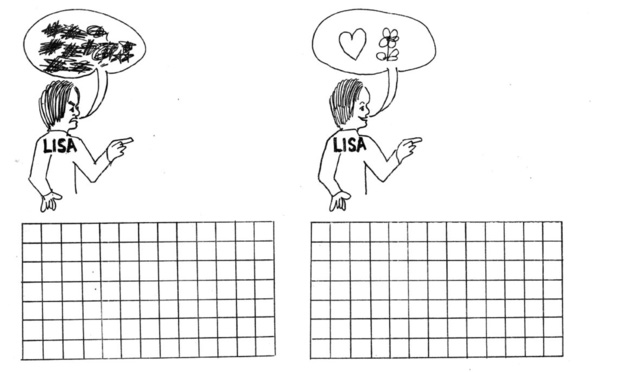 I wanted to investigate what would happen if I paired it with a recording sheet for positive comments at the same time. Well, I soon found that the “nice” side was meaningless! When she was at the clipboards for one of her put-down marks, she rapidly marked off the boxes of the hearts and flowers chart, inventing new things to say in order to add a mark. “I like you, Tom.” “I like your shirt, Tom” “I like your shoes, Tom.” Needless to say, the hearts and flowers record didn’t last long. With only the mistake sheet in operation, it took about 4 weeks for her put-downs to disappear.
I wanted to investigate what would happen if I paired it with a recording sheet for positive comments at the same time. Well, I soon found that the “nice” side was meaningless! When she was at the clipboards for one of her put-down marks, she rapidly marked off the boxes of the hearts and flowers chart, inventing new things to say in order to add a mark. “I like you, Tom.” “I like your shirt, Tom” “I like your shoes, Tom.” Needless to say, the hearts and flowers record didn’t last long. With only the mistake sheet in operation, it took about 4 weeks for her put-downs to disappear.
Lessons learned from Lisa: (1) Don’t use Personal Records for desirable behavior, because the record is not real. (2) Don’t put children’s names on Personal Record charts either, because it’s unnecessary and the concern can apply to everyone, not just Lisa.
Personal Record at Home
I have shown how a Personal Record offers an opportunity the responsibility for reflection and change in a school community. These examples belong to one person, dealing with one person’s habits. At home it is different.
The people impacted by mistakes at home are members of the family. Several family members may play a part in creating the habitual conditions which foster a problem. Usually they share the responsibility to reflect on their own piece of the evolving, even co-dependent, interpersonal relationships.
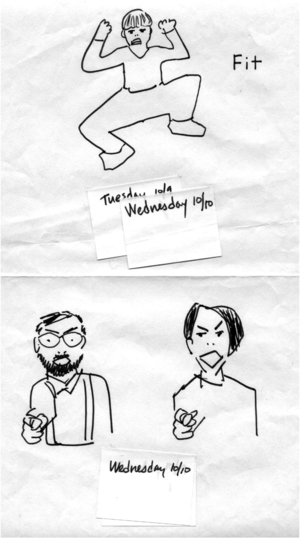
Since I did not have a copy machine at home to keep churning out new forms every day, I tried one drawing with a new daily sticky note for marking, which could be added as needed. Yes, that is supposed to be me. All three of us had problems, so everyone had to mark the chart. The child threw amazing fits, and the parents responded by getting angry. Neither is cool.
I offer this as an example of how a Personal Record can become a Family Record at home.
Unwilling Child?
I have been asked many times about what to do if children are unwilling to mark the Personal Record. I can only share with you my experience. Refusals have happened to me two times. The first time I said, “I am telling you about this now so you know about it. We are starting tomorrow.” The next day there was no push-back. In the second instance the child said to me with amazing conviction, “I am never going to mark that chart!” It was true; he never did. He also never made that mistake again, so there was no need to do it.
Next, and last, we go to another favorite consequence choice — Positive Practice.
Navigation Links
EXAMINE THE BEHAVIOR
INITIATE A PROGRAM
Examples of Sandy, Jeremy, and Charlie
